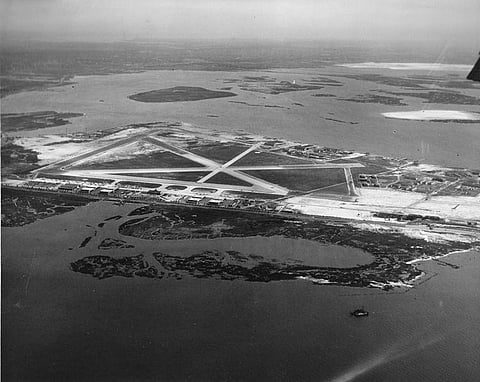
- Home
- न्यूजग्राम
- NewsGram USA
- India
- World
- Politics
- Entertainment
- Culture
- Lifestyle
- Economy
- Sports
- Sp. Coverage
- Misc.
- NewsGram Exclusive
- Jobs / Internships

Well known aviators such as Amelia Earhart, Charles Lindbergh, Roscoe Turner, Wiley Post, and Howard have graced the runways of New York City's first municipal airport, Floyd Bennett Field. The most amazing part is that during World War II, much of Floyd Bennett Field become a Naval Air Station.
Opened in 1931, the airport was named after aviator and Brooklyn native, Floyd Bennet. Bennett was the recipient of the Congressional Medal of Honor in 1926 after he flew to the North Pole.
Follow NewsGram on Facebook: NewsGram.com
Neither JFK nor LaGuardia were the first airports in New York. You heard that right! Hidden on Brooklyn's Atlantic coastline lies what was once a glistening airport; Floyd Bennett Field. This airport was far from being considered trash, aside from the fact that it was built on about six million tons of landfill. Nonetheless, this is the airport that witnessed the completion of many aviation records. The history in this small abandoned airport is richer than its frequent flyers once were.
Inside Floyd Bennett Field (NOP). Image source: Wikipedia
Many of the most renowned aviators started their journeys from Floyd Bennett. Amelia Earhart, was the first female pilot to fly across the Atlantic Ocean. Charles Lindbergh, was the first pilot to complete a solo nonstop flight across the Atlantic Ocean. Roscoe Turner, was recognized for his speed and was known to fly with his pet lion cub, Gilmore. Wiley Post, was the first to fly solo around the world, and he did so in front of a crowd of 50,000 at Floyd Bennet. Howard Hughes set the world record for flying fastest around the world.
Much like today's airports, Floyd Bennett Field bolstered an attractive terminal. Inside flyers could find the Aviation Bar & Grill, a newsstand, and even a radio studio. In this studio broadcasts of the newest aviation records and attempts were told to those who would listen.
Floyd Bennett Field in New York. Image source: Wikipedia
Records were broken and the wealthy flew out of Floyd Bennett Field. That seems like a lifetime ago, as what was once a glistening airport, now lies in ruins. The airplane hangars are empty (except one very special Hangar B). The control tower has been abandoned. The runway, which was the first one to be concrete and electrically lit, is now covered in weeds. These facts are disheartening. Luckily, for the vintage aircrafts that still reside at Floyd Bennett, there is a trusty group of volunteers working hard to maintain and repair some of the aircraft.
Follow NewsGram on Twitter: @newsgram1
In Hangar B lies all the vintage aircraft. The volunteer group, the Historic Aircraft Restoration Project (HARP) consists of dedicated volunteers. Many of whom are ex-Air Force mechanics, and some of whom are simply history enthusiasts. Each volunteer exhibits passion about the aircraft and works hard to keep the spirit of Floyd Bennett alive today.
In 1970, the National Park Service took control and started restoring Floyd Bennet. The first floor has been restored to almost all of its original design. A small museum has also been put in to tell guests of the legends and lives that once graced the terminal and runway. Unfortunately, the second floor is a different story. The second floor was put aside as the pilots quarters. The bedrooms and bathrooms found here are completely disheveled. Up even higher, you can find the control tour which is completely void of any aviation equipment.
Captain James A Mollison at Floyd Bennett Field, 23 October 1936 in front of his Bellanca Flash. Image source:Wikiwand
Unfortunately for Floyd Bennet, convenience is what eventually led to its demise as an airport. A new tunnel that connected Queens and Manhattan was built in 1940. Soon after, LaGuardia took home in northern Queens.
Once LaGuardia took over as New York's main airport, Floyd Bennet took on the role of Naval Base. More buildings were built so the Navy had gymnasiums, a place to store munitions, and dormitories. Even today some of these buildings are used by the Coast Guard and the NYPD.
Today HARP works hard to restore the planes in Hangar B as best as they can. Unfortunately, Floyd Bennett Field is not recognized as important by either the Smithsonian or New York. The volunteers that work on the aircraft are old and harbor specific sets of aircraft mechanical skills, skills that are nonexistent today. HARP volunteers hope to open Hangar B as a museum this summer, but are still working on repairing some planes.
Floyd Bennett Field is a historic treasure. The wealthy were attracted to its novelty. The daring aviators who broke records used it for takeoff and landing. When LaGuardia was built, and Floyd Bennet seemed as though it had run its course, it took on the role of Naval Base. Many of the volunteers seem to believe, Floyd Bennet Field is an aircraft's haven that should be seen and recognized by visitors.
-by Abigail Andrea, an intern at NewsGram. Twitter @abby_kono
ALSO READ:
